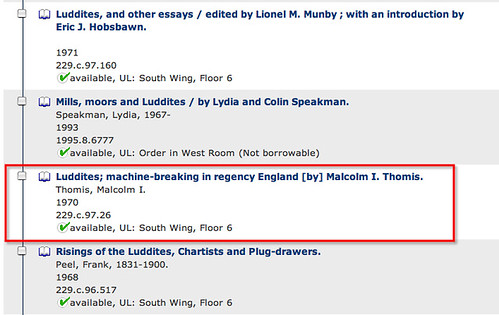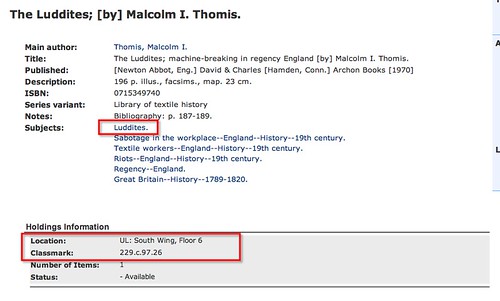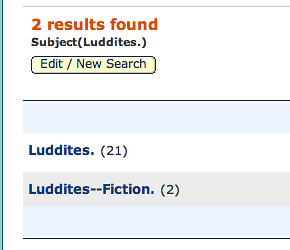
The location of the book - South Wing, Floor 6, 229.c.97.26 - is identified within the search results listing, as well as in the more detailed record for that item:

So I scribbled down the location and reference on a slip of paper, went into the stacks - the wrong stack at first (South Front... I think Huw said someone had mentioned proposing an Arcadia project on signage? Sign 'em up - please...) - and found the book. Now I remembered from the catalogue page that there were a couple of other works in a similar stack location - 229.c.97.* - but I hadn't scribbled down the actual reference numbers. The cataloguing system being as it is (categories, accession number within that category and size of book all feature) actual tracking down subject related works, even on the same stack, can be difficult without a reference number.
Being unfamiliar with the layout of South Wing, Floor 6, I wasn't sure where, or even whether, there was a catalogue terminal somewhere handy; what I really wanted was to be able to look-up the catalogue from my phone (not that using phones is allowed in the library...;-)
So what would this app have been able to do? Well what's immediately available:
- the book reference (229.c.97.26), which is a unique identifier for that work;
- the catalogue page for that work (see above).
The catalogue page contains a set of subject categories. Clicking through on the subject category link for Luddites leads to:

Clicking on the Luddites term on this page leads in turn to:

(Hmmm, that page doesn't say what subject term the results relate to?!)
That is, we have a list of works - along with their location, reference number and availability - available from the subject category.
So what would my first guess "In the Stacks" app look like? (I was going to do a quick run through using mockups generated using the Balsamiq mockup tool, but time is tight today:-(
The app would:
- take the reference number (e.g. 229.c.97.26)
- respond by showing the title of the work, its author, and related subjects (for confirmation).
- allow the user to click through on a subject and display other works classed using the same subject term, visibly grouped according to proximal location (e.g. grouping works 229.c.97.* first using the current example).
Then I would trivially be able to lookup items related by subject to a work I had discovered whilst in the shelves.
PS thinking on a little further, it might be handy to catalogue the range of reference number items as displayed on the end of each stack (a couple of days work, probably) so that the actual stack locations of each work could be identified, and maybe rendered on a map? (e.g. see e.g. Mashing and Mapping, Owen Stephens' description of his Middlemash hack looking at how the Google Maps interface might be used to display library floorplans).
Imagining further, how about users grabbing an image of the refrenc range sign on the end of a stack using something like Google Goggles, and getting a list back of works, possibly arranged by topic, on that stack?! ;-) Technology assisted serendipity! ;-)



1 comment:
Obviously I hate to bang on about this :) but along side the actually development work on a Library Map at #middlemash, a small group also brainstormed some requirements, and these have been collected on a wiki at http://www.mashedlibrary.com/wiki/index.php?title=Mapping_the_library
The requirements captured so far don't mention mobile applications specifically, although I think the requirements were generally seen as platform independent.
If you want to add your requirements to the wiki ... :)
Post a Comment